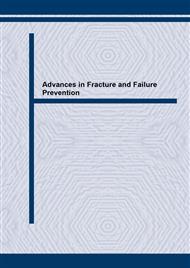p.687
p.693
p.699
p.705
p.711
p.717
p.723
p.729
p.735
Finite Element Analysis of Rubber Particles Size Distribution on Fracture Toughness of Rubber-Modified Polymer
Abstract:
A numerical study on the effects of the distribution of rubber particles size on the fracture toughness of rubber-modified polymer alloys was computed. FEM analyses were conducted on the deformation field near the crack tip under mode I for small scale yielding condition. Near the crack tip is modelled as composite of matrix materials and rubber particles. On the other hand, outer region is modelled as homogeneous material whose constitutive equation has been obtained by analysing unit cell model of matrix and rubber particle. Perfect bonding or partial debonding of the interface is assumed in the computation. Matrix and rubber particles are treated as Mises and Mooney-Rivlin materials, respectively. It is shown that energy flux into fracture process zone; Ĵ -integral is smaller for bimodal type than monomodal one. This behavior largely occurred on the partial debonding case. These results imply that the screening effects occurred in the bimodal type larger than monomodal one.
Info:
Periodical:
Pages:
711-716
Citation:
Online since:
April 2004
Authors:
Keywords:
Price:
Сopyright:
© 2004 Trans Tech Publications Ltd. All Rights Reserved
Share:
Citation:


